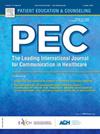Active and direct patient participation in health professions education: A narrative overview of literature from the global south
IF 2.9
2区 医学
Q2 PUBLIC, ENVIRONMENTAL & OCCUPATIONAL HEALTH
引用次数: 0
Abstract
Objectives
Patients traditionally played a passive role in health professions education (HPE). However, their active involvement is increasingly valued, particularly in higher-resourced regions of the world known as the Global North. This study explores active and direct patient involvement in HPE contexts in the Global South (GS) regions of the world.
Methods
A narrative review of literature was conducted, utilising a systematic search of multiple electronic databases. 3966 abstracts were identified, and 80 full texts were reviewed. Ultimately, five papers were included in the final corpus.
Results
The selected studies were set in five GS countries, involving undergraduate, postgraduate medical and pharmacy training. Real patients, their caregivers and standardized patients acted as teachers or assessors focusing on learners' history-taking, communication skills, and professionalism. Challenges included cultural sensitivity and safety concerns, e.g. during home visits. Educators faced difficulties in patient recruitment, training and compensation.
Conclusion & practice implications
Active and direct patient involvement in HPE within GS contexts remains limited. Current efforts focus on patients as teachers or assessors, with little contribution to educational design, instruction and mentoring. Educators may be overlooking the potential of diverse cultural perspectives to enhance patient engagement in HPE, making this a valuable area for future research.
积极和直接的患者参与卫生专业教育:来自全球南方文献的叙述概述
目的:传统上,患者在卫生职业教育中处于被动地位。然而,它们的积极参与越来越受到重视,特别是在被称为全球北方的资源较丰富的地区。本研究探讨了全球南方(GS)地区患者在HPE环境中的积极和直接参与。方法系统检索多个电子数据库,进行文献综述。摘要3966篇,全文80篇。最终,五篇论文被纳入最终的语料库。结果所选研究设置在五个GS国家,涉及本科、研究生医学和药学培训。真正的病人、他们的护理人员和标准化的病人充当教师或评估员,重点关注学习者的历史记录、沟通技巧和专业精神。挑战包括文化敏感性和安全问题,例如在家访期间。教育工作者在患者招募、培训和补偿方面面临困难。结论,实践意义在GS背景下,积极和直接的患者参与HPE仍然有限。目前的努力主要是将患者作为教师或评估者,对教育设计、指导和指导的贡献很少。教育工作者可能忽视了不同文化视角在提高患者参与HPE方面的潜力,使其成为未来研究的一个有价值的领域。
本文章由计算机程序翻译,如有差异,请以英文原文为准。
求助全文
约1分钟内获得全文
求助全文
来源期刊

Patient Education and Counseling
医学-公共卫生、环境卫生与职业卫生
CiteScore
5.60
自引率
11.40%
发文量
384
审稿时长
46 days
期刊介绍:
Patient Education and Counseling is an interdisciplinary, international journal for patient education and health promotion researchers, managers and clinicians. The journal seeks to explore and elucidate the educational, counseling and communication models in health care. Its aim is to provide a forum for fundamental as well as applied research, and to promote the study of organizational issues involved with the delivery of patient education, counseling, health promotion services and training models in improving communication between providers and patients.
 求助内容:
求助内容: 应助结果提醒方式:
应助结果提醒方式:


